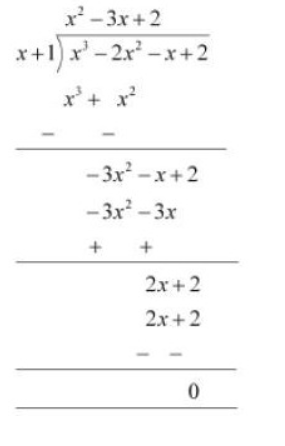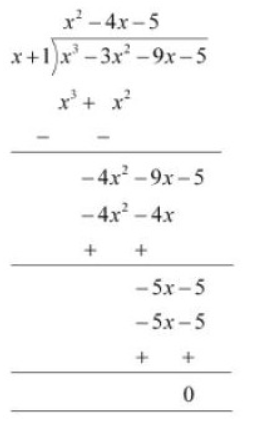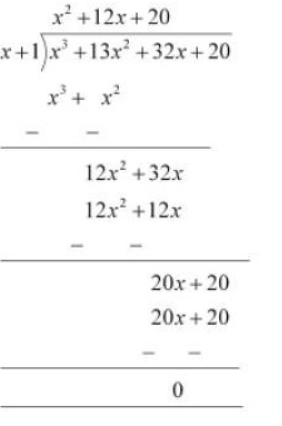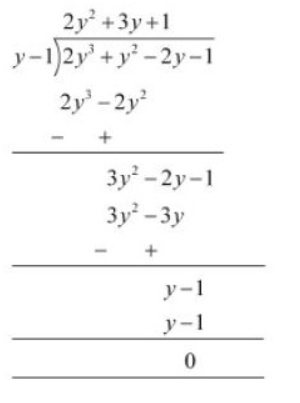NCERT Solutions for Class 9 Maths Chapter 2 Exercise 2.3 - Polynomials
The fundamental aspects of algebraic expressions and equations rely on polynomials and factors. These mathematical tools provide a means to handle intricate expressions and solve equations of elevated complexity. The Factor Theorem is an essential method for polynomial factor determination because it allows users to evaluate whether linear expressions such as (x–a) exist as factors within another polynomial by testing specific numerical values.
This Story also Contains
- NCERT Solutions for Class 9 Maths Chapter 2 – Polynomials Exercise 2.3
- Access Polynomials Class 9 Chapter 2 Exercise: 2.3
- Topics Covered in Chapter 1 Number System: Exercise 2.3
- NCERT Solutions of Class 9 Subject Wise
- NCERT Exemplar Solutions of Class 9 Subject Wise

Students learn to identify polynomial factors using a combination of substitution tests and evaluation approaches with middle-term splitting methods. The NCERT Solutions provide students with step-by-step solutions for polynomial problems sourced directly from the newest NCERT Books. The exercise functions as an essential tool for solidifying knowledge, which leads to a complete understanding of problems and their practical applications.
Access Polynomials Class 9 Chapter 2 Exercise: 2.3
Q1 (i) Determine which of the following polynomials has $(x + 1)$ a factor : $x^3 + x^2 +x + 1$
Answer:
Let p(x) = x3 + x2 + x +1
Use the Factor Theorem, which says:
If p(–1) = 0, then (x + 1) is a factor of the polynomial p(x).
So, p(−1) = (−1)3 + (−1)2 + (−1) + 1 = -1 + 1 - 1 + 1 = 0
Therefore, Yes, (x + 1) is a factor of polynomial $p(x)=x^3 + x^2 +x + 1$
Q1 (ii) Determine which of the following polynomials has $(x + 1)$ a factor : $x^4 + x^3 + x^2 +x + 1$
Answer:
Let p(x) = x4 + x3 + x2 + x + 1
Use the Factor Theorem, which says:
If p(–1) = 0, then (x + 1) is a factor of the polynomial p(x).
So, p(−1) = (−1)4 + (−1)3 + (−1)2 + (−1) + 1 = 1 - 1 + 1 - 1 + 1 = 1
Therefore, No, (x + 1) is not a factor of polynomial $p(x)=x^4 + x^3 + x^2 +x + 1$
Q1 (iii) Determine which of the following polynomials has $(x + 1)$ a factor : $x^4 + 3x^3 + 3x^2 +x + 1$
Answer:
Let p(x)= x4 + 3x3 + 3x2 + x + 1
Use the Factor Theorem, which says:
If p(–1) = 0, then (x + 1) is a factor of the polynomial p(x).
So, p(−1) = (−1)4 + 3(−1)3 + 3(−1)2 + (−1) + 1 = 1 - 3 + 3 - 1 + 1 = 1
Therefore, No, (x + 1) is not a factor of polynomial $p(x)=x^4 + 3x^3 + 3x^2 +x + 1$
Answer:
Let p(x) = $x^3 - x^2 -(2 + \sqrt2)x + \sqrt2$
Use the Factor Theorem, which says:
If p(–1) = 0, then (x + 1) is a factor of the polynomial p(x).
So, $p(-1) = (-1)^3 - (-1)^2 - (2+\sqrt{2})(-1) + \sqrt{2}$ = $-1 - 1 + 2 + \sqrt{2} + \sqrt{2}$ = $2\sqrt{2} \neq 0$
Therefore, No, (x + 1) is not a factor of polynomial p(x) = $x^3 - x^2 -(2 + \sqrt2)x + \sqrt2$
Answer:
g(x) = 0
⇒ x + 1 = 0
⇒ x = −1
Now, p(−1) = 2(−1)3 + (−1)2 – 2(−1) –1 = −2 + 1 + 2 −1 = 0
Therefore, Yes, g(x) is a factor of p(x)
Answer:
g(x) = 0
⇒ x + 2 = 0
⇒ x = −2
Now,
p(−2) = (−2)3 + 3(−2)2 + 3(−2) + 1
= − 8 + 12 − 6 + 1
= −1 ≠ 0
Therefore, No, g(x) is not a factor of p(x)
Answer:
g(x) = 0
⇒ x − 3 = 0
⇒ x = 3
Now,
p(3) = (3)3 − 4(3)2 + (3) + 6
= 27 − 36 + 3 + 6
= 0
Therefore, yes, g(x) is a factor of p(x).
Q3 (i) Find the value of k , if $x - 1$ is a factor of p(x) in the following case: $p(x) = x^2 + x + k$
Answer:
As (x - 1) is a factor of p(x), it means that p(1) = 0
So, By the Factor Theorem
⇒ (1)2 + (1) + k = 0
⇒ 1 + 1 + k = 0
⇒ 2 + k = 0
⇒ k = −2
Answer:
As (x - 1) is a factor of p(x), it means that p(1) = 0
So, by the factor theorem
⇒ $2(1)^2 + k(1) + \sqrt2$ = 0
⇒ $2 + k + \sqrt2$ = 0
⇒ k = $-2 - \sqrt2$
Answer:
As (x - 1) is a factor of p(x), it means that p(1) = 0
So, by the factor theorem
⇒ $k(1)^2-\sqrt2 (1) + 1$ = 0
⇒ k = $ - 1 + \sqrt2$
Q3 (iv) the value of k , if $x - 1$ is a factor of p(x) in the following case: $p(x) = kx^2 -3 x + k$
Answer:
As (x - 1) is a factor of p(x), it means that p(1) = 0
So, by the factor theorem
⇒ $k(1)^2 -3 (1) + k$ = 0
⇒ k − 3 + k = 0
⇒ 2k − 3 = 0
⇒ k = $\frac{3}{2}$
Q4 (i) Factorise : $12x^2 - 7x + 1$
Answer:
Given polynomial is $12x^2 - 7x + 1$
We need to factorise the middle term into two terms such that their product is equal to $12 \times 1 = 12$ and their sum is equal to $-7$
We can solve it as
$\Rightarrow 12x^2 - 7x + 1$
$\Rightarrow 12x^2-3x-4x+1$ $(\because -3 \times -4 = 12 \ \ and \ \ -3+(-4) = -7)$
$\Rightarrow 3x(4x-1)-1(4x-1)$
$\Rightarrow (3x-1)(4x-1)$
Q4 (ii) Factorise : $2x^2 + 7x + 3$
Answer:
Given polynomial is $2x^2 + 7x + 3$
We need to factorise the middle term into two terms such that their product is equal to $2 \times 3 = 6$ and their sum is equal to $7$
We can solve it as
$\Rightarrow 12x^2 - 7x + 1$
$\Rightarrow 2x^2+6x+x+3$ $(\because 6 \times 1 = 6 \ \ and \ \ 6+1 = 7)$
$\Rightarrow 2x(x+3)+1(x+3)$
$\Rightarrow (2x+1)(x+3)$
Q4 (iii) Factorise : $6x^2 +5x - 6$
Answer:
Given polynomial is $6x^2 +5x - 6$
We need to factorise the middle term into two terms such that their product is equal to $6 \times -6 =-3 6$ and their sum is equal to $5$
We can solve it as
$\Rightarrow 6x^2 +5x - 6$
$\Rightarrow 6x^2 +9x -4x - 6$ $(\because 9 \times -4 = -36 \ \ and \ \ 9+(-4) = 5)$
$\Rightarrow 3x(2x+3)-2(2x+3)$
$\Rightarrow (2x+3)(3x-2)$
Q4 (iv) Factorise : $3x^2 - x - 4$
Answer:
Given polynomial is $3x^2 - x - 4$
We need to factorise the middle term into two terms such that their product is equal to $3 \times -4 =-12$ and their sum is equal to $-1$
We can solve it as
$\Rightarrow 3x^2 - x - 4$
$\Rightarrow 3x^2 -4 x+3x - 4$ $(\because 3 \times -4 = -12 \ \ and \ \ 3+(-4) = -1)$
$\Rightarrow x(3x-4)+1(3x-4)$
$\Rightarrow (x+1)(3x-4)$
Q5 (i) Factorise : $x^3 - 2x^2 - x +2$
Answer:
Given polynomial is $x^3 - 2x^2 - x +2$
Now, by the hit and trial method, we observed that $(x+1)$ is one of the factors of the given polynomial.
By the long division method, we will get
 We know that Dividend = (Divisor $\times$ Quotient) + Remainder
We know that Dividend = (Divisor $\times$ Quotient) + Remainder
$x^3 - 2x^2 - x +2 = (x+1)(x^2-3x+2)+0$
$= (x+1)(x^2-2x-x+2)$
$= (x+1)(x-2)(x-1)$
Therefore, on factorization of $x^3 - 2x^2 - x +2$ we will get $(x+1)(x-2)(x-1)$
Q5 (ii) Factorise : $x^3 - 3x^2 -9x -5$
Answer:
Given polynomial is $x^3 - 3x^2 -9x -5$
Now, by the hit and trial method, we observed that $(x+1)$ is one of the factors of the given polynomial.
By the long division method, we will get
 We know that Dividend = (Divisor $\times$ Quotient) + Remainder
We know that Dividend = (Divisor $\times$ Quotient) + Remainder
$x^3 - 3x^2 -9x -5=(x+1)(x^2-4x-5)$
$= (x+1)(x^2-5x+x-5)$
$= (x+1)(x-5)(x+1)$
Therefore, on factorization of $x^3 - 3x^2 -9x -5$ we will get $(x+1)(x-5)(x+1)$
Q5 (iii) Factorise : $x^3 + 13x^2 + 32x + 20$
Answer:
Given polynomial is $x^3 + 13x^2 + 32x + 20$
Now, by the hit and trial method, we observed that $(x+1)$ is one of the factors of the given polynomial.
By the long division method, we will get
 We know that Dividend = (Divisor $\times$ Quotient) + Remainder
We know that Dividend = (Divisor $\times$ Quotient) + Remainder
$x^3 + 13x^2 + 32x + 20=(x+1)(x^2+12x+20)$
$= (x+1)(x^2+10x+2x+20)$
$= (x+1)(x+10)(x+2)$
Therefore, on factorization of $x^3 + 13x^2 + 32x + 20$ we will get $(x+1)(x+10)(x+2)$
Q5 (iv) Factorise : $2y^3 + y^2 - 2y - 1$
Answer:
Given polynomial is $2y^3 + y^2 - 2y - 1$
Now, by the hit and trial method, we observed that $(y-1)$ is one of the factors of the given polynomial.
By the long division method, we will get
 We know that Dividend = (Divisor $\times$ Quotient) + Remainder
We know that Dividend = (Divisor $\times$ Quotient) + Remainder
$2y^3 + y^2 - 2y - 1= (y-1)(2y^2+3y+1)$
$= (y-1)(2y^2+2y+y+1)$
$= (y-1)(2y+1)(y+1)$
Therefore, on factorization of $2y^3 + y^2 - 2y - 1$ we will get $(y-1)(2y+1)(y+1)$
Also Read-
Topics Covered in Chapter 1 Number System: Exercise 2.3
- Application of Factor Theorem: The Factor Theorem helps us check whether a given expression, like (x – a), is a factor of a polynomial by substituting a into the polynomial. If the result is zero, then (x–a) is a factor.
- Verifying factors of polynomials: The verification of a factor requires replacing its factor zero value with the target x value in the polynomial expression. The output becomes zero when the given expression functions as a factor.
- Finding unknown constants using factor conditions: We obtain an equation for polynomials through the substitution of known factors. We obtain the missing constant by solving the derived equation.
- Factorisation of cubic and quadratic polynomials: Various methods such as splitting the middle term, Factor Theorem and algebraic identities exist for the factorisation of quadratic and cubic polynomials.
- Grouping method for factorisation: The grouping method allows grouping polynomial terms into pairs or sets so that factors can be extracted to achieve simpler and factorised expressions.
Check Out-
NCERT Solutions of Class 9 Subject Wise
Students must check the NCERT solutions for class 9 of the Mathematics and Science Subjects.
NCERT Exemplar Solutions of Class 9 Subject Wise
Students must check the NCERT solutions for class 9 of the Mathematics and Science Subjects.
Frequently Asked Questions (FAQs)
Middle term theorem is used to find roots/zeros of equation ax² + bx + c= 0 that means we have to find that roots whose sum = -(b/a) and the product is equal to c/a
The degree of the constant polynomial is 0. Taking example is, 2 is a constant polynomial that is equal to 2x^0, so its degree is 0.
There are a total of 5 types of questions in the exercise 2.4
Comparing the above polynomial with ax² + bx + c= 0, a= 3, b = 6 and c= 9, hence sum of roots = -(b/a) = -(6/3) = -2
Product of roots = c/a = 9/3 = 3
Courses After 12th
Applications for Admissions are open.
As per latest syllabus. Physics formulas, equations, & laws of class 11 & 12th chapters
JEE Main Important Chemistry formulas
Get nowAs per latest syllabus. Chemistry formulas, equations, & laws of class 11 & 12th chapters
JEE Main high scoring chapters and topics
Get nowAs per latest 2024 syllabus. Study 40% syllabus and score upto 100% marks in JEE
JEE Main Important Mathematics Formulas
Get nowAs per latest syllabus. Maths formulas, equations, & theorems of class 11 & 12th chapters
